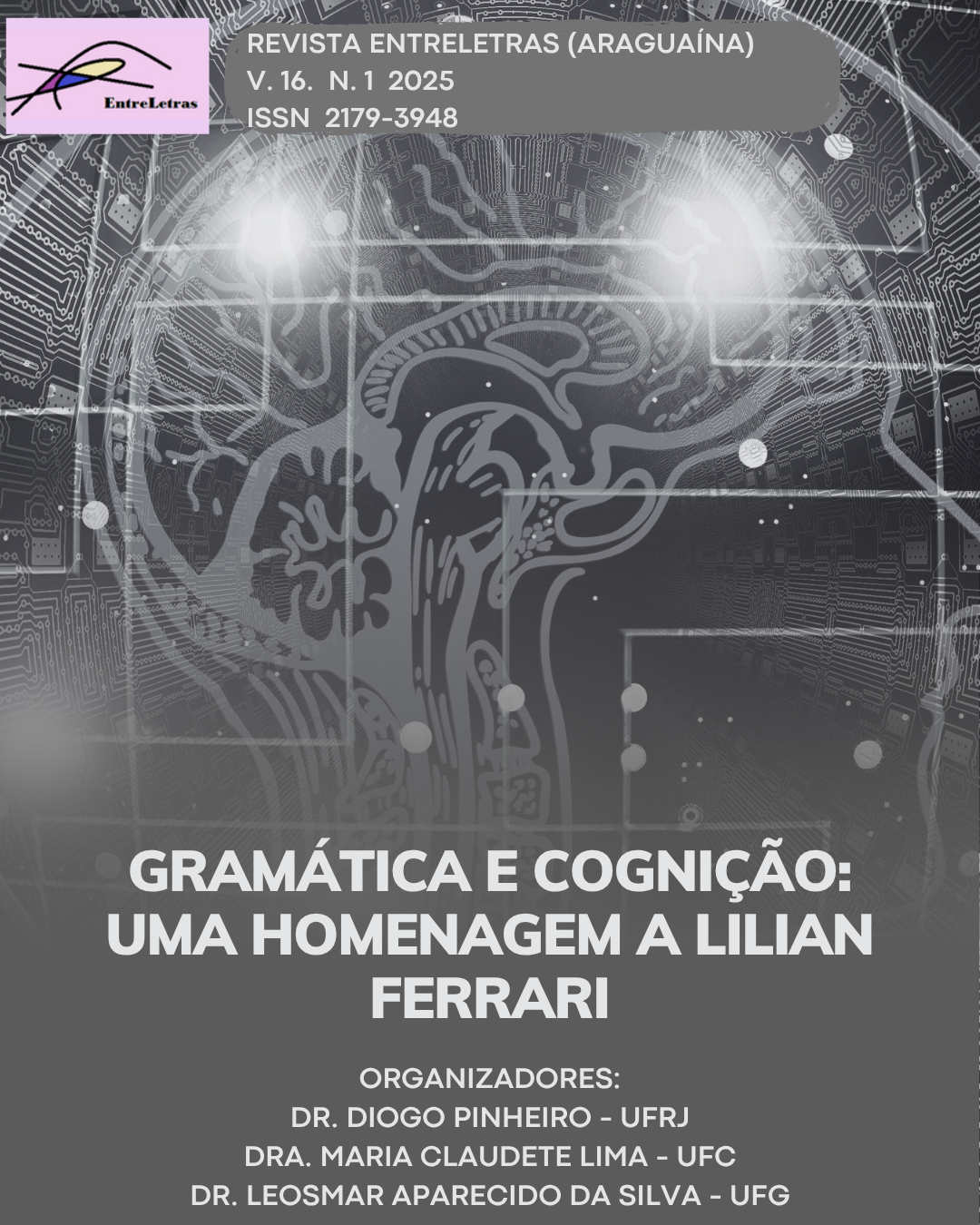A CONSTRUÇÃO “BE LIKE” COMO INTERAÇÃO FICTIVA
DOI:
https://doi.org/10.70860/ufnt.entreletras.e19597Palavras-chave:
be like, mudança linguística, abordagem cognitivo-funcionalResumo
A construção “be like” (ser como), usada para introduzir discurso direto, tem sido investigada sob perspectiva sociolinguística, como comum entre jovens. Este estudo, em abordagem cognitivo-funcional, visa examinar essa construção como marcador de interação fictiva. Para tanto, analisa, conforme variáveis mórficas e semântico-discursivas, dados do século XX e XXI, do Corpus COCA. Os resultados revelam aumento da frequência de uso no século XXI, especialmente na fala, predominantemente em primeira pessoa, no pretérito e expressando pensamentos. Tais dados sugerem que esta construção não apenas reflete uma mudança na forma de citar, mas também revela nuances na expressão de pensamentos e emoções.
Downloads
Referências
BARBIERI, Federica. Quotative Use in American English: A Corpus-Based, Cross-Register Comparison. Journal of English Linguistics, Arizona , v. 33, n. 3, p. 222-256, 2005. DOI: 10.1177/0075424205282667 Disponível em: https://www.researchgate.net/publication/249700171_Quotative_Use_in_American_EnglishA_Corpus-Based_Cross-Register_Comparison. Acesso em: 01 de fevereiro de 2025.
BLYTH, Carl Jr., RECKTENWALD, Sigrid; WANG, Jenny. I'm like, 'Say what?!': A new quotative in American oral narrative. American Speech. v. 65, n. 3, p. 215-227, 1990. DOI: https://doi.org/10.2307/455910 Disponível em: https://www.jstor.org/stable/455910. Acesso em: 01 de fevereiro de 2025.
BUCHSTALLER, Isabelle. Quotatives: New Trends and Sociolinguistic Implications. Oxford: Wiley-Blackwell, 2014.
D’ARCY, Alexandra. The diachrony of quotation: Evidence from New Zealand English. Language Variation and Change. Inglaterra, v. 24, n. 3, p. 343-369, 2012. DOI: 10.1017/S0954394512000166 Disponível em: https://www.cambridge.org/core/journals/language-variation-and-change/article/abs/diachrony-of-quotation-evidence-from-new-zealand-english/6A0FD8DABE133806EE3EA73A703C06A6. Acesso em: 03 de fevereiro de 2025.
DENG, Delin. “She’s Like Why You Speak English While Dreaming?”: A Corpus-Based Study of Quotative Markers Used by Chinese Speakers of L2 English. Languages, Gainesville, v. 8, n. 1, p. 51, 2023. DOI: 10.3390/languages8010051 Disponível em: https://www.mdpi.com/2226-471X/8/1/51. Acesso em: 03 de fevereiro de 2025.
DEUBER, Dagmar; HÄNSEL, Eva Canan; WESTPHAL, Michael. Quotative be like in Trinidadian English. World Englishes, Münster, v. 40, n. 3, p. 436-458, 2021. DOI: 10.1111/weng.12465 Disponível em https://onlinelibrary.wiley.com/doi/10.1111/weng.12465. Acesso em: 03 de fevereiro de 2025.
JARDINE, Katelyn. He’s Like, “My Nan Loves That Naan Bread”: Quotative Be+Like and Mimetic Performance Among Migrants to St. John’s NL. 2022. 94 páginas. Tese (Mestre em Artes) - Escola de Estudos de Pós graduação Departamento de Linguística, Universidade Memorial de Newfoundland, Canadá, 2022.
KAMBON, Obadelé Bakari; DUAH, Reginald Akuoko. Non-african linguists be like, “this is a new way to quote!. Ghana Journal of Linguistics, Ghana, v. 6, n. 2, p. 85-115, 2017. DOI: 10.4314/gjl.v6i2.5 Disponível em: https://www.ajol.info/index.php/gjl/article/view/164004. Acesso em: 03 de fevereiro de 2025.
LANGACKER, Ronald Wayne. Foundations of Cognitive Grammar. Volume I: Theoretical Prerequisites. Stanford: Stanford University Press, 1987.
LANGACKER, Ronald Wayne. Cognitive grammar: a basic introduction. Oxford university press, 2008.
LANGACKER, Ronald Wayne. Ten lectures on the elaboration of cognitive grammar. Leiden/Boston: Brill, 2017.
MEEHAN, Teresa. It’s like, ‘what’s happening in the evolution of like?’: A theory of grammaticalization. Kansas Working Papers in Linguistics. Lawrence, v. 16: 37–51, 1991.
DOI: 10.17161/KWPL.1808.423 Disponível em: https://journals.ku.edu/kwpl/article/view/17306. Acesso em: 03 de fevereiro de 2025.
PASCUAL, Esther. Imaginary trialogues: conceptual blending and fictive interaction in Criminal Courts, Amsterdam, Landelijke Onderzoekschool Taalwetenschap, 2002.
PASCUAL, Esther. Fictive interaction within the sentence: a communicative type of fictivity in grammar. Cognitive Linguistics. Birmingham, v. 17, n. 2, p. 245-267, 2006. DOI: 10.1515/COG.2006.006 Disponível em: https://www.degruyter.com/document/doi/10.1515/COG.2006.006/html. Acesso em: 03 de fevereiro de 2025.
RAUŠOVÁ, Veronika. Discourse-pragmatic functions of like in spoken discourse. 2023. Tese (Doutorado em filologia e ensino da língua inglesa). - Faculdade de filosofia e Instituto de língua Inglesa e Didática, Universidade Carolina, Praga, 2023.
TAGLIAMONTE, Sali, D'ARCY, Alex. When people say, "I was like …" The quotative system in Canadian youth. Working Papers in Linguistics. v. 10, n. 2 (Selected Papers from NWAVE 32): 257–272.
TALMY, Leonard. Toward a cognitive semantics. London: MIT, 2003.
VANDELANOTTE, Lieven. Be like and friends: Grammar, figuration and subjectivity. Séminaire du LERMA. Anais... Aix Maiselle Université: LERMA, 2018. Disponível em: https://lerma.univ-amu.fr/wp-content/uploads/2020/11/Abstract-Vandelanotte-25052018.pdf. Acesso em: 17 dez. 2024.
VANDELANOTTE, Lieven. (Non-)quoting and subjectivity in online discourse. Revue électronique d’études sur le monde anglophone. Marselha, v. 17, n. 2, 2020. DOI: 10.4000/erea.9782 Disponível em: http://journals.openedition.org/erea/9782. Acesso em: 17 dez. 2024.
Downloads
Publicado
Como Citar
Edição
Seção
Licença
Copyright (c) 2025 EntreLetras

Este trabalho está licenciado sob uma licença Creative Commons Attribution 4.0 International License.
Os autores mantêm os direitos autorais e concedem à revista o direito de primeira publicação, com o trabalho simultaneamente licenciado sob a Creative Commons 4.0 que permite o compartilhamento do trabalho com reconhecimento da autoria do trabalho e publicação inicial nesta revista.
Os autores têm autorização para assumir contratos adicionais separadamente, para distribuição não-exclusiva da versão do trabalho publicada nesta revista (ex.: publicar em repositório institucional ou como capítulo de livro), com reconhecimento de autoria e publicação inicial nesta revista.










